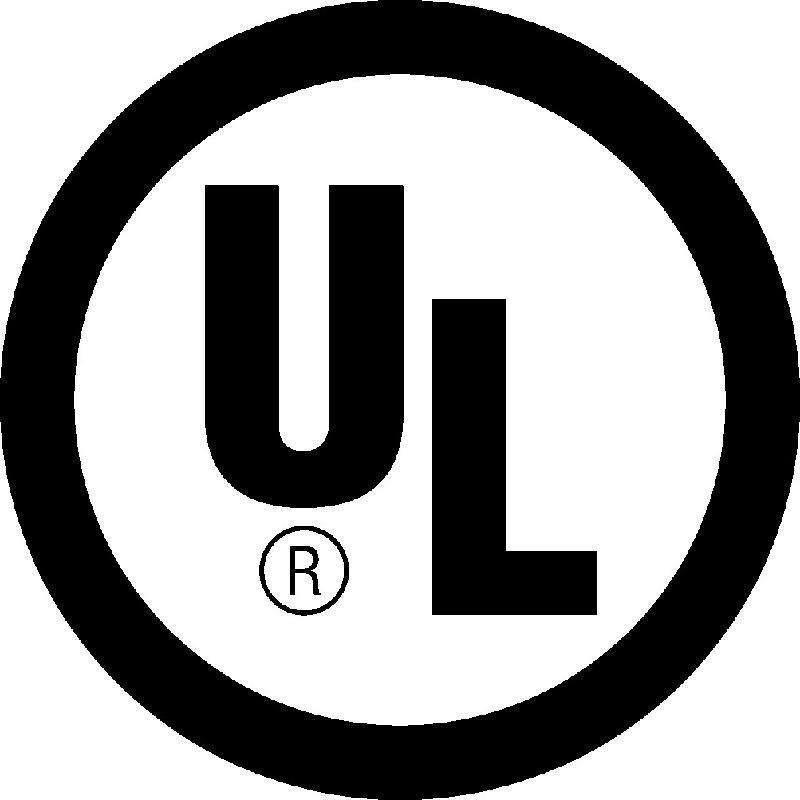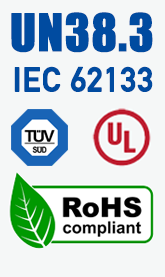What’s the UL2054?

Scope of UL2054 Certification
What’s a UL2054 certification? What’s UL2054 certification of a lithium-ion battery? What are the test items of UL1642 certification? You can find all answers here!
General of UL2054 Certification
1.1 UL2054 certification requirements cover portable primary (non-rechargeable) and secondary (rechargeable) lithium-ion batteries for use as a power supply in goods. These lithium-ion batteries consist of either a single electrochemical cell or two or more lithium-ion cells connected in parallels or series, or both, that convert chemical energy into electrical energy by chemical reaction.
1.2 UL2054 certification requirements intend to reduce the risk of explosion or fire when lithium-ion batteries are working in a device. The proper use of these lithium-ion batteries in a particular application is dependent on their use in a complete product that complies with the requirements applicable to such a product.
1.3 UL2054 certification requirements are intended to cover lithium-ion batteries for general use. They do not include the combination of the lithium-ion battery and the host product, which are covered by specifications in the host product standard.
1.4 UL2054 certification requirements are also intended to reduce the risk of injury to persons due to fire or explosion when lithium-ion batteries are removed from a product to be transported, stocked, or discarded.
1.5 UL2054 certification requirements do not cover the toxicity risk that results from the ingestion of a lithium-ion battery or its contents, nor the risk of injury to somebody that occurs if a lithium-ion battery is open to provide access to its contents.
Glossary of UL2054 Certification
2.1 Instead of the UL2054 certification requirements outlined in table 6.1, lithium-ion cells constructed of lithium metal, lithium alloy, or lithium-ion that are used in batteries shall meet the conditions in the standard for lithium-ion batteries UL 1642
2.2 Units of measurement
2.3 Terminology
2.4 Components
2.4.1 Except as indicated in 2.4.2, a component of a product covered by this standard shall comply with UL2054 certification requirements for the element. See appendix for a list of rules covering parts used in the products covered by this UL2054 standard.
2.4.2 A component is not required to comply with a specific requirement that: Involves a feature or characteristic not needed for the application of the element in the product covered by UL2054 standard or is superseded by a condition in UL2054 standard.
2.4.3 A component shall be used following its rating established for the intended conditions of use.
2.4.4 Specific parts are incomplete in construction features or restricted in performance capabilities. The components are intended for use only under limited conditions, such as certain temperatures not exceeding specified limits, and shall be used only under those specific conditions.
Performance of UL2054 Certification
4.1.1 The casing of a lithium-ion cell or single-cell battery, or the enclosure of a lithium polymer battery pack shall have the strength and rigidity required to resist the possible abuses, that it is exposed to during its intended use, in order to reduce the risk of fire or injury to persons.
4.1.2 The casing of a lithium-ion battery pack shall be rigid enough to prevent flexing. A tool providing the construction advantage of pliers, screwdriver, hacksaw, or similar device, shall be the minimum automated capability required to open the casing.
4.1.3 For lithium-ion battery packs with plastic outer enclosures, the external ring of the battery shall be designed such that it is not capable of being opened using simple tools, such as a screwdriver. The enclosure shall be ultrasonically welded or secured by equivalent means. Adhesives complying with the adhesive requirements of the Standard for Polymeric Materials – Use in Electrical Equipment Evaluations, UL 746C, single-use, or tamper-proof screws are considered equivalent means.
4.1.4 The outer case body of the lithium-ion battery shall be classed as V-1 or less flammable in the minimum part thickness under the Standard for Polymeric Materials — Use in Electrical Equipment Evaluations, UL 746C.
Exception: Materials are not required to be classed as V-1 or less flammable when they comply with the Enclosure Flammability – 20 mm (3/4 inch) Flame test specified in the Standard for Polymeric Materials– Use in Electrical Equipment Evaluations, UL 746C.
4.1.5 Openings in lithium-ion battery pack enclosures shall minimize to prevent damage to lithium-ion cells, connections, and internal circuitry and too short of electrical spacings within the lithium-ion battery pack. Enclosure openings shall not be located over lithium-ion cells that do not comply with the rigid casing requirements of 4.1.2 or overprotective circuitry and connections where damage or shorting from debris entering the enclosure could result in a hazard.
4.2 Electrolyte
4.2.1 A lithium-ion cell shall not contain pressurized vapor or liquid that expels materials forcibly when the lithium-ion battery casing is punctured with a grinding wheel under laboratory conditions at a temperature of 23 ±2°C (73±3.6°F).
4.3 External Lithium-ion Battery Pack Connectors
4.3.1 An external lithium-ion battery pack connector shall be constructed to prevent unpremeditated short-circuiting of its terminals unless the pack meets the limited power supply requirements of the Limited Power Source Test, Section 13. Examples of methods to avoid inadvertent short-circuiting include recessing the terminals, providing circuitry that prevents inadvertent short-circuiting, providing covers over the terminals, use of keyed connectors, and the like.
4.3.2 Insulating material for external battery pack connectors, outside the enclosure, shall have a V-2 minimum flame rating unless the pack meets the limited power source requirements of the Limited Power Source Test, Section 13. External connectors forming part of the fire enclosure shall be V-1 minimum.
4.4 Printed wiring boards
4.4.1 Printed wiring boards positioning lithium-ion battery circuit components shall be rated V-1 minimum
4.5 Lithium-ion systems
4.5.1 The voltage of each lithium-ion cell or each cellblock consisting of parallel-connected plural cells should not exceed the upper limit of the charging voltage specified by the battery manufacturer.
4.5.2 For the lithium-ion battery consisting of a single cell or a separate cellblock, it should be confirmed that the charging voltage of the cell does not exceed the upper limit of the charging voltage specified by the battery manufacturer.
4.5.3 For the lithium-ion battery consisting of series-connected single cells or series-connected cellblocks, it should be confirmed that the voltages of any one of the individual cells or single cellblocks does not exceed the upper limit of the charging voltage, specified by the cell manufacturer, by monitoring the energy of every single cell or the single cellblocks.
4.5.4 Compliance for 4.5.1 – 4.5.3 can be achieved through analysis of the lithium-ion battery protection circuit or, if unable to determine through analysis, then through monitoring values during the test of Section 13A.
Samples of UL2054 Certification
5.1 Lithium-ion batteries are to be tested as described in Sections 9 through 24. Section 12, Forced-Discharge Test, is applicable only to lithium-ion cells intended to be used in multi-cell series applications, such as lithium-ion battery packs. The Battery Enclosure Tests, Sections 18 — 21 (including the 250 N Steady Force, Mold Stress Relief, and Drop Impact Tests) are intended only for batteries that have a plastic outer enclosure.
5.2 With the exclusion of the Projectile Test of Section 22, lithium-ion cells and batteries shall not explode or catch fire as a result of the tests in this standard. For the Shock Test, Section 16, Vibration Test, Section 17, 250 N Steady Force Test, Section 19, Mold Stress Relief Test, Section 20, Drop Impact Test, Section 21, and the Temperature Cycling Test, Section 24 the samples shall also not vent or leak. For these tests, unacceptable leakage is deemed to have occurred when the resulting mass loss exceeds the values shown in Table 5.1, Venting, and Leakage Mass Loss Criteria.
5.3 Deleted August 12, 2008
5.4 Certain end product devices require that the power output of a lithium-ion battery be limited. The Limited Power Source Test described in Section 13 is to be used to determine whether a lithium-ion cell or battery is suitable in such applications where fire hazards may otherwise exist.
Important Test Considerations of UL2054 Certification
6.1 Unless otherwise indicated, new lithium-ion cells or batteries in the fully charged state are to be used for the tests described in Sections 9 – 24. The test schedule and the number of samples to be used in each analysis are shown in Tables 6.1 and 6.2, for cell testing and battery pack testing, respectively.
6.2 When a lithium-ion battery pack is tested in accordance with Table 6.2, the lithium-ion cells comprising that battery pack shall also be tested in accordance with Table 6.1 if they have not already been.
6.3 All lithium-ion batteries shall be wholly charged in accordance with the battery manufacturer’s specifications prior to testing except for the samples to be subjected to the Abnormal Charging and Abusive Overcharge Tests, which shall be discharged to the manufacturer specified endpoint voltage using the manufacturer specified current prior to testing.


